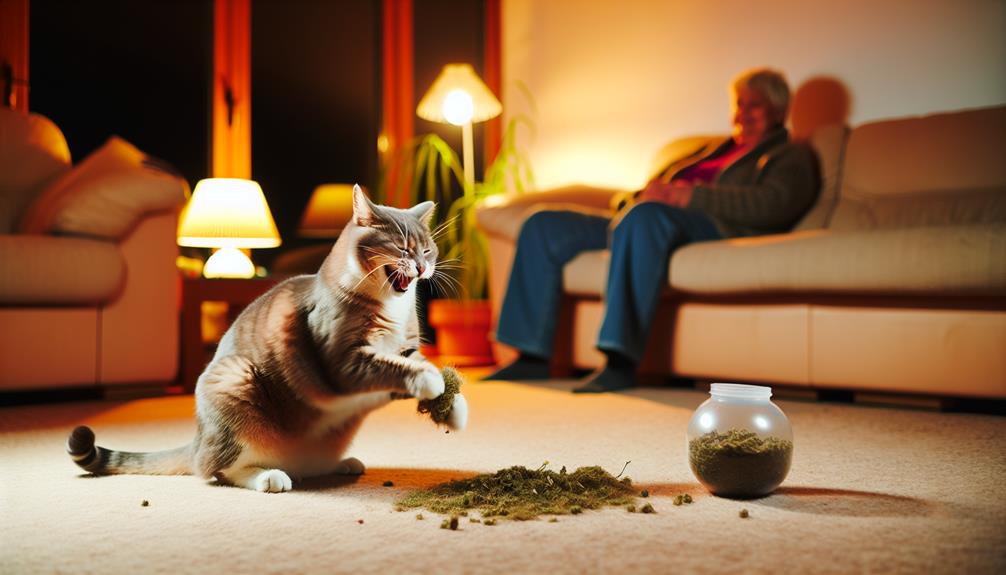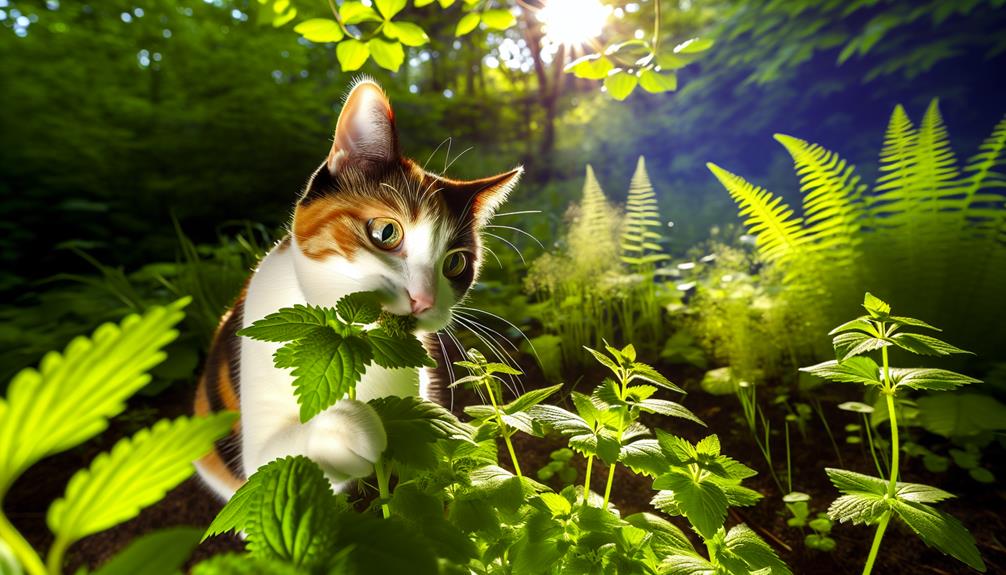Did you know that approximately 70-80% of cats are affected by catnip? While it's generally safe, giving your feline friend too much can lead to some worrying symptoms like vomiting or increased aggression. You'll want to know how to balance the benefits and potential risks, especially if you're considering adding catnip to your cat's routine. So, what exactly makes catnip both a fun and potentially hazardous treat for cats?
What Is Catnip
Catnip, scientifically known as Nepeta cataria, is a herb belonging to the mint family. Its origins can be traced back to Europe, Asia, and Africa, where it has been used for centuries in traditional medicine and as a feline attractant. The plant thrives in a variety of climates and is characterized by its heart-shaped leaves and clusters of small, lavender flowers. Understanding catnip's origins is vital in grasping the full scope of its properties and effects.
There are several types of catnip, each with slight variations in their chemical compositions and effects. The most common type is Nepeta cataria, widely recognized for its high concentration of the active compound nepetalactone. This compound is primarily responsible for the herb's ability to elicit behavioral responses in cats. Other varieties include Nepeta mussinii and Nepeta racemosa, which also contain nepetalactone but in varying amounts and may exhibit different potencies.
In addition to these, there's also the less commonly known Japanese catnip (Schizonepeta tenuifolia), which shares some similar properties but isn't as widely studied or utilized. Each of these catnip types can be found in different forms, such as dried leaves, sprays, and essential oils, providing a range of options for various applications.
When considering catnip for your feline, it's important to understand these distinctions. Not all catnip types are created equal, and their differing compositions can result in varying levels of efficacy and safety. By comprehending the origins and types of catnip, you can make informed decisions that align with the needs and well-being of your cat.
How Catnip Affects Cats
When your cat encounters catnip, you'll notice distinct behavioral changes such as euphoria, rolling, and purring, which usually last about 10 to 15 minutes. The duration of these effects is temporary, and sensitivity to catnip varies considerably among individual cats, with approximately 30% showing no response. Understanding these variations can help you gauge whether catnip is beneficial or merely a fleeting pleasure for your feline companion.
Behavioral Changes Observed
Many cats exhibit distinct behavioral changes upon exposure to catnip, a phenomenon driven by the compound nepetalactone. As a feline-specific compound, nepetalactone binds to olfactory receptors, triggering a cascade of neurological responses. Clinically, you'll observe an array of reactions, from heightened playful antics to noticeable calming effects.
Playful behaviors often include rolling on the floor, pawing at invisible objects, and chasing imaginary prey. These behaviors are indicative of a hyperactive state, likely due to the stimulation of neural pathways associated with predatory instincts. Cats may also exhibit increased vocalization and erratic running, often described as "zoomies."
On the other hand, some cats display calming effects post-exposure. This can manifest as a state of relaxation, characterized by purring, drooling, and a general decrease in activity levels. These soothing behaviors are likely due to the activation of opioid receptors, which can produce a mild sedative effect.
Clinically, it's important to recognize that the variability in response is influenced by genetic factors and individual sensitivity. Approximately 50-70% of cats are responsive, while the remainder show little to no reaction. Understanding these behavioral changes is essential for responsible catnip use, ensuring it's both enjoyable and safe for your feline companion.
Temporary Effects Duration
Typically, the effects of catnip on cats are transient, lasting anywhere from 5 to 30 minutes. When a cat first inhales catnip, the active compound nepetalactone binds to receptors inside the cat's nasal tissue, rapidly inducing a state of temporary euphoria. This phase is often characterized by behaviors such as rolling, rubbing, purring, and playful aggression. The intensity of these responses varies, but they generally peak within the first 10 minutes.
After this initial period, the acute effects begin to wane. However, some lingering effects can persist. For instance, your cat might still exhibit mild relaxation or reduced anxiety for an additional 10 to 15 minutes. This secondary phase is often less intense and can be easily overlooked if you're not closely monitoring your pet.
It's essential to understand that while the euphoric state is temporary, these lingering effects do not typically cause any harm. The transient nature of catnip's effects guarantees that there is a natural limitation to its impact. To summarize, the overall duration of catnip's influence is brief, and any prolonged behavioral changes are usually minimal and non-detrimental.
Sensitivity Variations Among Cats
Although catnip is widely known for its intriguing effects on felines, not all cats exhibit the same level of sensitivity to this herb. Individual reactions to catnip can differ considerably, primarily due to genetic factors. Research indicates that approximately 50-70% of cats are affected by catnip, leaving a notable minority that shows no reaction at all.
Sensitivity variations among cats can be categorized as follows:
- Genetic Predisposition: The ability to respond to catnip is hereditary. If neither parent reacts to catnip, their offspring are less likely to exhibit any response. Conversely, if both parents are sensitive, there's a higher probability their kittens will display sensitivity.
- Age Dependency: Kittens and older cats often don't respond to catnip. The sensitivity generally manifests when a cat reaches sexual maturity, typically around six months old. Similarly, senior cats may exhibit diminished reactions due to age-related changes in sensory and neurological functions.
- Behavioral Expression: Among cats that do react, individual responses can range from playful antics to calm relaxation. Some may exhibit hyperactivity, while others may become more subdued. These variations are linked to the individual cat's temperament and neurological makeup.
Understanding these factors can help you better manage and predict your cat's reaction to catnip.
Benefits of Catnip

Catnip, scientifically known as Nepeta cataria, offers several notable benefits for feline companions. One of the primary catnip uses is its ability to induce a state of euphoria or calm in cats, thanks to the compound nepetalactone. When cats sniff catnip toys, they often exhibit behaviors such as rolling, rubbing, and vocalizing, which can be interpreted as signs of pleasure and enjoyment. This stimulant effect is akin to a mild form of recreational enrichment, which can be beneficial for both physical and mental health.
From a clinical perspective, catnip can serve as a non-pharmacological method to reduce stress and anxiety in cats. This can be particularly useful in multi-cat households or during potentially stressful situations like vet visits or thunderstorms. The herb's calming properties can help cats cope more effectively with environmental stressors, thereby improving their overall well-being.
Moreover, incorporating catnip toys into your cat's play routine can promote physical activity. Active play stimulated by catnip can help combat obesity, a common issue among domestic cats, by encouraging more dynamic and vigorous interactions. Cats that engage with catnip toys are more likely to exercise, which can lead to improved cardiovascular health, muscle tone, and joint flexibility.
In addition, catnip can be a useful tool for training and behavior modification. Sprinkling a bit of catnip on scratching posts or inside carriers can make these items more appealing, guiding your cat towards desired behaviors. Utilizing catnip in this manner can make the training process more effective and less stressful for both you and your feline companion.
Potential Side Effects
While many cats enjoy the benefits of catnip, there are potential side effects that owners should be aware of. Though generally considered safe, catnip can sometimes lead to adverse reactions. Understanding these side effects is vital in ensuring the well-being of your feline friend.
Firstly, catnip toxicity can occur if a cat ingests an excessive amount. Symptoms of toxicity may include vomiting, diarrhea, and lethargy. Although rare, these symptoms indicate that the cat's digestive system is struggling to process the plant. It's important to monitor the amount of catnip your cat consumes to prevent such occurrences.
Secondly, some cats may experience allergic reactions to catnip. These reactions can manifest as skin irritations, such as itching, redness, or swelling. In more severe cases, respiratory symptoms like sneezing or wheezing may occur. If you notice any of these signs, it's advisable to discontinue catnip exposure and consult your veterinarian for further guidance.
Thirdly, behavioral changes can also be a side effect of catnip exposure. While many cats exhibit playful and relaxed behaviors, some may become overly aggressive or hyperactive. These behavioral shifts can cause stress and anxiety, both for the cat and its owner.
Here's a concise list of potential side effects:
- Catnip toxicity: Symptoms include vomiting, diarrhea, and lethargy.
- Allergic reactions: Manifestations include skin irritations and respiratory issues.
- Behavioral changes: Ranging from aggression to hyperactivity.
Safe Usage Guidelines

To guarantee catnip is safe for your cat, you should adhere to guidelines on dosage amounts and frequency of exposure. Typically, small quantities administered once or twice a week are sufficient to prevent any adverse effects. It's also essential to monitor your cat's behavior for any signs of overstimulation or distress.
Appropriate Dosage Amounts
Determining the appropriate dosage amounts of catnip for your feline is vital to guarantee their safety and enjoyment. Catnip toxicity is rare but can occur if excessive quantities are ingested. Consequently, adhering to dosage recommendations is essential for maintaining your cat's well-being.
Evidence-based guidelines suggest the following safe usage practices:
- Initial Testing: Start with a small amount, approximately 1 teaspoon of dried catnip or a small pinch of fresh leaves. Monitor your cat's reaction to ascertain there are no adverse effects.
- Regular Usage: A dosage of 1-2 teaspoons of dried catnip or a few fresh leaves can be given. This amount is generally sufficient to elicit a positive response without risking toxicity.
- Catnip Toys: Pre-filled catnip toys are designed with safety in mind. Confirm that the toy is from a reputable manufacturer and monitor your cat to prevent overexposure.
It's important to observe your cat's behavior and adjust the dosage accordingly. Signs of overconsumption include vomiting, diarrhea, or lethargy, indicating a need to reduce the amount provided. By following these guidelines, you can confirm that your pet enjoys the benefits of catnip without any adverse effects.
Frequency of Exposure
Establishing the appropriate frequency of catnip exposure is vital for ensuring your cat's safety and maximizing their enjoyment. To achieve this balance, you need to evaluate your cat's individual catnip tolerance and adhere to recommended exposure limits. Research suggests offering catnip no more than once or twice per week. This frequency helps prevent the development of desensitization, where your cat becomes less responsive to the effects of catnip over time.
Clinical observations indicate that frequent exposure can diminish the plant's efficacy and potentially lead to behavioral changes. Consequently, it's advisable to maintain a controlled schedule, ensuring that each exposure is a distinct, enjoyable event. By doing so, you help preserve the positive effects of catnip and avoid any potential negative consequences.
Additionally, understanding your cat's tolerance is important. Some cats might exhibit heightened sensitivity, necessitating even stricter exposure limits. It's important to start with minimal exposure and observe any immediate reactions. Gradually increasing the frequency, while remaining within the recommended guidelines, can help identify your cat's ideal tolerance level.
Monitoring Cat Behavior
In addition to managing the frequency of catnip exposure, monitoring your cat's behavior is essential for safe usage. Observing feline play and other behavioral cues can help guarantee that catnip's effects remain beneficial rather than detrimental.
- Watch for Overstimulation: While catnip often results in playful antics, some cats may become overly excited, leading to aggressive behavior. If your cat's play turns from light-hearted to intense or aggressive, it's vital to remove the catnip and give them time to calm down.
- Assess Post-Exposure Recovery: After catnip exposure, your cat should return to their normal behavior within 30 minutes to an hour. Prolonged lethargy or hyperactivity might indicate sensitivity to catnip, suggesting a need to limit future use.
- Monitor for Physical Symptoms: Vomiting, diarrhea, or excessive drooling are signs that your cat may be reacting negatively to catnip. Such symptoms warrant reducing or altogether ceasing catnip use and consulting with a veterinarian if they persist.
Catnip Alternatives
Several viable alternatives to catnip can offer similar stimulation and enrichment for your feline companion. One effective option is silvervine (Actinidia polygama), a plant that has been shown to elicit an even stronger response in cats compared to catnip. Additionally, valerian root (Valeriana officinalis) is known for its euphoric effects on felines, often resulting in playful and energetic behavior.
Catnip toys can also be substituted with toys infused with alternative herbal blends. For instance, toys filled with silvervine or valerian root provide both physical and olfactory stimulation. Dried honeysuckle wood is another notable alternative; it contains compounds that can induce similar reactions in cats as catnip.
Here's a comparative overview of some catnip alternatives:
| Alternative | Active Compound(s) | Effects on Cats |
|---|---|---|
| Silvervine | Actinidine, Matatabilactone | Increased playfulness, euphoria |
| Valerian Root | Actinidine, Valepotriates | Energized, sometimes calming |
| Honeysuckle Wood | Unspecified Aromatic Compounds | Playful behavior, curiosity |
| Herbal Blends | Various (e.g., chamomile, rosemary) | Varied: calming to stimulating |
Silvervine, in particular, has garnered attention for its dual active compounds, actinidine and matatabilactone, which are highly stimulating. Valerian root contains actinidine and valepotriates, often leading to vigorous activity followed by calmness. Honeysuckle wood, though less studied, has demonstrated similar behavioral effects in felines.
Expert Opinions

When evaluating the safety and benefits of catnip and its alternatives, it's vital to consult veterinary experts and feline behaviorists. These professionals provide invaluable insights, debunking common catnip myths and guiding responsible usage. Their expert insights can help you make informed decisions that optimize your cat's well-being.
Veterinary experts often emphasize that catnip, in moderation, is generally safe for cats. However, they caution against excessive exposure due to potential overstimulation or gastrointestinal upset. According to feline behaviorists, the following points are important to take into account:
- Behavioral Responses Vary: Not all cats respond to catnip. Approximately 50-70% of felines exhibit a reaction, which can range from hyperactivity to relaxation. This variability underscores the need for a personalized approach to catnip use.
- Short-Term Effects: The effects of catnip are typically short-lived, lasting around 10-15 minutes. After this period, cats often enter a refractory phase where they become temporarily immune to its effects. Experts suggest limiting sessions to avoid diminishing returns.
- Alternative Enrichments: For cats unresponsive to catnip or those requiring diversified stimulation, experts recommend alternatives like silvervine, valerian root, and interactive toys. These options can provide similar benefits without the risk of habituation.
Debunking catnip myths is vital for ensuring the safety and happiness of your feline companion. For instance, contrary to popular belief, catnip is not addictive, nor does it pose significant health risks when used appropriately. By leveraging expert insights, you can foster a balanced and enriching environment for your cat, enhancing their quality of life while minimizing potential drawbacks.
Conclusion
To sum up, catnip can be a fantastic addition to your cat's environment when used responsibly. While it's not a miracle cure for all feline woes, its benefits are substantial. However, like anything, too much of a good thing can lead to problems such as vomiting or increased aggression. Stick to the guidelines—limit exposure to once or twice a week and monitor your cat's reactions. With careful use, catnip can provide immense joy and enrichment for your furry friend.
